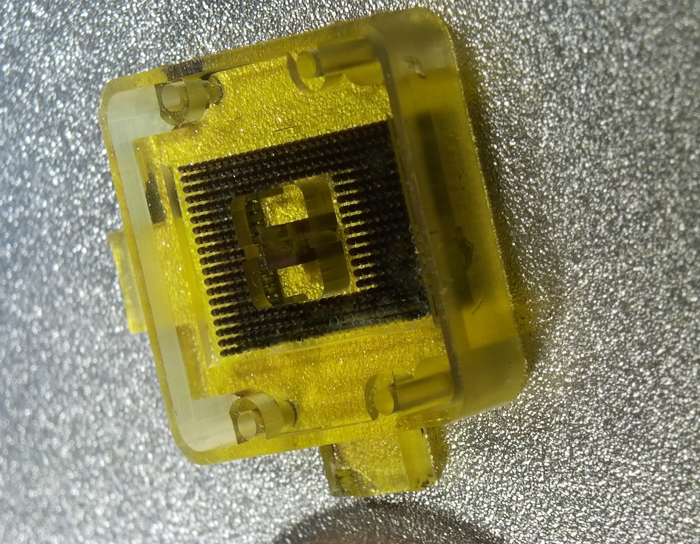Horizon Microtechnologies has achieved success in creating a high-frequency D-Band horn antenna through micro 3D printing. However, this achievement did not rely solely on 3D printing; it involved a combination of processes. Specifically, the creation of the copper-coated antenna involved a technique where the coating process is integrated with 3D printing.
“The work on the high frequency D-band horn antenna used our HMT-Metal coating process, with which copper layers can be applied very evenly and conformally to a variety of component shapes and materials,” Horizon CEO Andreas Frölich explained. “From a commercial perspective, such components fit well with the use of micro-AM as they are typically in the cm size range, with sub-mm dimensions, and require the attainment of micron tolerances. The market demands such antenna and other mm-wave components to exhibit higher frequencies and connectivity for use in industrial measurement technology, sensor technology and communication applications with very low latencies. Being able to make such mm-wave components via micro-AM allows the production of smaller and lighter weight components, and also opens up the possibility of making them with properties and geometric features impossible using alternative fabrication processes.”
Polymer 3D printed components can be coated with metal for various reasons. In this particular instance, the final horn component produced is 15% smaller and one-sixth the weight of traditional ones, which is significant in the satellite and space industries where reducing mass is crucial. Horizon specializes in micro 3D printed parts and has developed several coating processes tailored for small vat polymerization parts. The company’s range of coatings includes copper, protective, and transparent conductive coatings. These coatings are applied to parts produced using a Boston Micro Fabrication (BMF) S240 DLP system, enabling Horizon to manufacture parts within a 10 cm x 10 cm x 7.5 cm build volume. Alongside design services, Horizon claims it can achieve dimensional accuracy within plus or minus 10 µm from the CAD files. The firm then applies the coatings in-house.
The coatings and processes have been specifically tailored to enhance part performance. Horizon’s copper coatings, which have a thickness of 1 to 2 µm, can be applied in a targeted manner. This selective application enables the integration of features like pins, leads, and mountings directly within a polymer component, allowing a single 3D printed part to consist of both conductive and non-conductive areas. This capability enables Horizon to produce conformal, exceptionally small, and functionally integrated components.
However, Horizon is not the only company exploring advanced applications in this field. Horn antennas can also be created using powder bed fusion technology. Collaborative research by the University of British Columbia and Drexel University has demonstrated that antennas can be 3D printed in polyamide and subsequently dipped in a newfangled material known as MXene, yielding effective results. This approach offers an alternative method for producing high-performance antenna components.
Initial testing of the antenna indicates that its performance is on par with existing solutions. Given this promising start, future iterations could be easily and swiftly produced, surpassing the turnaround time of traditional methods. Moreover, future designs could incorporate specific patterns and textures to enhance the horn antenna’s performance, particularly in terms of directivity and gain—key factors in energy conversion efficiency.
Horizon also produces other components, like filters and mixers, which suggests potential for further optimizations in integrated communication units. The RF industry prioritizes SWaP—size, weight, and power—as a critical performance metric. Integrating various elements, such as mixers, into a single assembly could significantly improve performance, reduce part count, cut mass, and eliminate the need for fasteners, leading to multiple benefits in assembly.
Additionally, the cost of assembly is usually high, and errors can be extremely costly, prompting companies, especially those focused on Six Sigma methodologies, to minimize assembly and process steps. As the demand for horn antennas grows in satellite, rocketry, and terrestrial communications, combining micro 3D printing with specialized coating processes emerges as a cost-effective production strategy.
This convergence of trends and technologies underscores why I’m extremely excited about the prospects for companies like Optisys, SwissTo12, and now Horizon. They are positioned to tap into a significant market that aligns perfectly with our strengths, presenting an ideal opportunity for growth and innovation in 3D printing.
Subscribe to Our Email Newsletter
Stay up-to-date on all the latest news from the 3D printing industry and receive information and offers from third party vendors.
You May Also Like
Further Understanding of 3D Printing Design at ADDITIV Design World
ADDITIV is back once again! This time, the virtual platform for additive manufacturing will be holding the first-ever edition of ADDITIV Design World on May 23rd from 9:00 AM –...
3D Printer Maker EVO-tech Reborn as NEVO3D — Once More With Feeling
EVO-tech was a 3D printing service and original equipment manufacturer established in 2013 and based in Schörfling am Attersee, Austria. The company produced high-quality material extrusion systems featuring linear bearings,...
3D Systems Brings 3D Printed PEEK Cranial Implant to the U.S. with FDA Clearance
For more than 10 years, 3D Systems (NYSE:DDD) has worked hand-in-hand with surgeons to plan over 150,000 patient-specific cases, and develop more than two million instruments and implants from its...
CDFAM Returns to Berlin for Second Annual Symposium
The second CDFAM Computational Design Symposium is scheduled for May 7-8, 2024, in Berlin, and will convene leading experts in computational design across all scales. Building upon the first event...
































